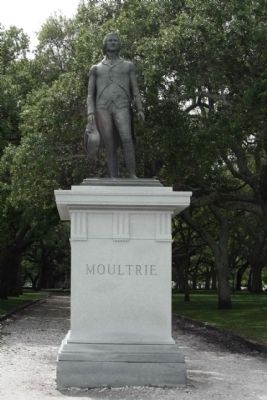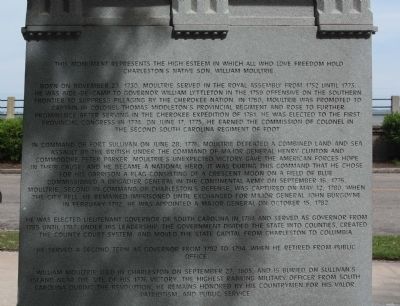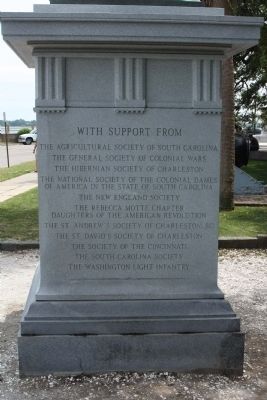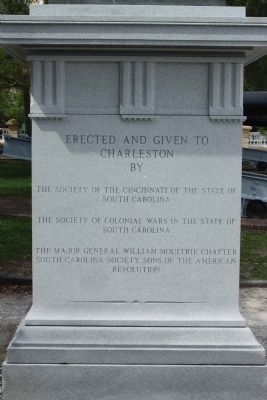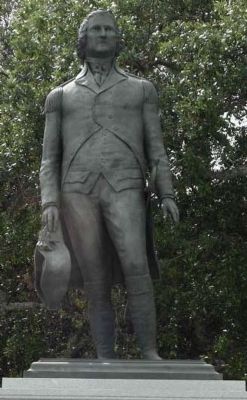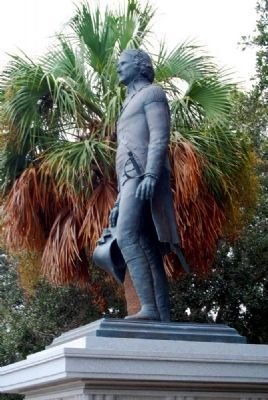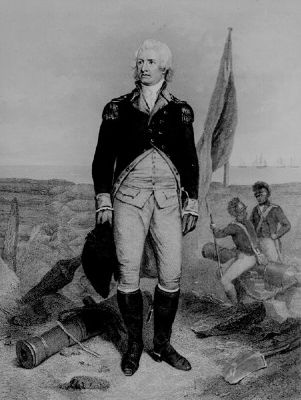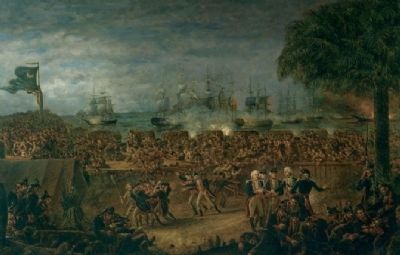South of Broad in Charleston in Charleston County, South Carolina — The American South (South Atlantic)
Moultrie
(West Face):
This Monument represents the high esteem in which all who love freedom hold Charleston's native son, William Moultrie
Born November 23, 1730, Moultrie served in the Royal Assembly from 1752 until 1773. He was Aide-de-Camp to Governor William Lyttleton in the 1759 offensive on the southern frontier to suppress pillaging by the Cherokee Nation. In 1760, Moultrie was promoted to captain in Colonel Thomas Middleton's Provincial Regiment and rose to further prominence after serving in the Cherokee Expedition of 1761. He was elected to the First Provincial Congress in 1774. On June 17, 1775 , he earned the commission of Colonel in the Second South Carolina Regiment of Foot.
In command of Fort Sullivan on June 28, 1776, Moultrie defeated a combined land and sea assult by the British under the command of Major General Henry Clinton and Commodore Peter Parker. Moultrie's unexpected victory gave the American forces hope in their cause, and he became a national hero. It was during this command that he chose for his garrison a flag consisting of a crescent moon on a field of blue. Commissioned a Brigadier General in the Continental Army on September 16, 1776. Moultrie, second in command of Charleston's defense, was captured on May 12, 1780, when the city fell. He remained imprisoned until exchanged for Major General John Burgoyne in February 1782. He was appointed a Major General on October 15, 1782.
He was elected Lieutenant Governor of South Carolina in 1784 and served as Governor from 1785 until 1787. Under his leadership, the government divided the state into counties, created the County Court System, and moved the State Capital from Charleston to Columbia.
He served a second term as Governor from 1792 to 1794, when he retired from public office.
William Moultrie died in Charleston on September 27, 1805 and is buried on Sulivan's Island near the site of his 1776 victory. The highest ranking military officer from South Carolina during the Revolution, he remains honored by his countrymen for his valor, patriotism and public service.
(North Face):
The Agriculture Society of South Carolina
The General Society of Colonial Wars
The Hibernian Society of Charleston
The National Society of the Colonial Dames
of America in the State of South Carolina
The New England Society
The Rebecca Motte Chapter
Daughters of the American Revolution
The St. Andrew's Society of Charleston, SC
The St. Davis Society of Charleston
The Society of Cincinnati
The South Carolina Society
The Washington Light Infantry
(South face):
Charleston By
The Society of the Cincinnati of the State
of South Carolina
The Society of Colonial Wars in the State
of South Carolina
The Major General William Moultrie Chapter
South Carolina Society of the American
Revolution
Erected by Society of the Cincinnati of the State of South Carolina; Society of Colonial Wars in the State of South Carolina; Major General William Moultrie Chapter, South Carolina Society Sons of the American Revolution.
Topics and series. This historical marker is listed in these topic lists: Colonial Era • Patriots & Patriotism • War, US Revolutionary • Wars, US Indian. In addition, it is included in the Daughters of the American Revolution series list. A significant historical month for this entry is February 1782.
Location. 32° 46.183′ N, 79° 55.734′ W. Marker is in Charleston, South Carolina, in Charleston County. It is in South of Broad. Marker is on East Battery Street, on the right when traveling south. Between South Battery Street and Murray Boulevard, in White Point Garden. Touch for map. Marker is in this post office area: Charleston SC 29401, United States of America. Touch for directions.
Other nearby markers. At least 8 other markers are within walking distance of this marker. Ten - Inch Smooth Bore Columbaid Cannon (here, next to this marker); Eleven - Inch Dahlgren Gun (a few steps from this marker); To the Defenders of Fort Moultrie (a few steps from this marker); a different marker also named Ten - Inch Smooth Bore Columbaid Cannon (within shouting distance of this marker); USS Pringle (DD-477) (within shouting distance of this marker); Hurricane Hugo (within shouting distance of this marker); Confederate Defenders of Charleston (within shouting distance of this marker); William Gilmore Simms (within shouting distance of this marker). Touch for a list and map of all markers in Charleston.
Also see . . .
1. William Moultrie. William Moultrie (November 23, 1730 – September 27, 1805) was a general from South Carolina in the American Revolutionary War. (Submitted on September 24, 2011, by Brian Scott of Anderson, South Carolina.)
2. William Lyttelton, 1st Baron Lyttelton. William Henry Lyttelton, 1st Baron Lyttelton (24 December 1724 – 14 September 1808) was the youngest son of Sir Thomas Lyttelton, 4th Baronet. (Submitted on September 24, 2011, by Brian Scott of Anderson, South Carolina.)
3. Anglo-Cherokee War. The Anglo-Cherokee War (1758–1761) (Cherokee: "War with those in the red coats" or "War with the English"), also known (from the Anglo-European perspective) as the Cherokee War, the Cherokee Uprising, the Cherokee Rebellion, was a conflict between British forces in North America and Cherokee Indians during the French and Indian War. (Submitted on September 24, 2011, by Brian Scott of Anderson, South Carolina.)
4. Fort Moultrie. Fort Moultrie is the name of a series of citadels on Sullivan's Island, South Carolina, built to protect the city of Charleston, South Carolina. (Submitted on September 24, 2011, by Brian Scott of Anderson, South Carolina.)
5. Fort Sumter National Monument > Fort Moultrie. The first fort on Sullivan's Island was still incomplete when Commodore Sir Peter Parker and nine warships attacked it on June 28, 1776. (Submitted on September 24, 2011, by Brian Scott of Anderson, South Carolina.)
6. Henry Clinton. General Sir Henry Clinton KB (16 April 1730 – 23 December 1795) was a British army officer and politician, best known for his service as a general during the American War of Independence. (Submitted on September 24, 2011, by Brian Scott of Anderson, South Carolina.)
7. Sir Peter Parker, 1st Baronet. Admiral of the Fleet Sir Peter Parker, 1st Baronet (1721–1811) was a British naval officer. (Submitted on September 24, 2011, by Brian Scott of Anderson, South Carolina.)
8. John Burgoyne. General John Burgoyne (24 February 1722 – 4 August 1792) was a British army officer, politician and dramatist. (Submitted on September 24, 2011, by Brian Scott of Anderson, South Carolina.)
Credits. This page was last revised on April 24, 2023. It was originally submitted on May 20, 2009, by Mike Stroud of Bluffton, South Carolina. This page has been viewed 2,195 times since then and 59 times this year. Last updated on April 24, 2023, by Carolyn Sanders of Plano, Texas. Photos: 1, 2, 3, 4. submitted on May 20, 2009, by Mike Stroud of Bluffton, South Carolina. 5. submitted on January 5, 2012, by Mike Stroud of Bluffton, South Carolina. 6. submitted on September 25, 2011, by Brian Scott of Anderson, South Carolina. 7. submitted on May 20, 2009, by Mike Stroud of Bluffton, South Carolina. 8. submitted on September 25, 2011, by Brian Scott of Anderson, South Carolina. • J. Makali Bruton was the editor who published this page.
